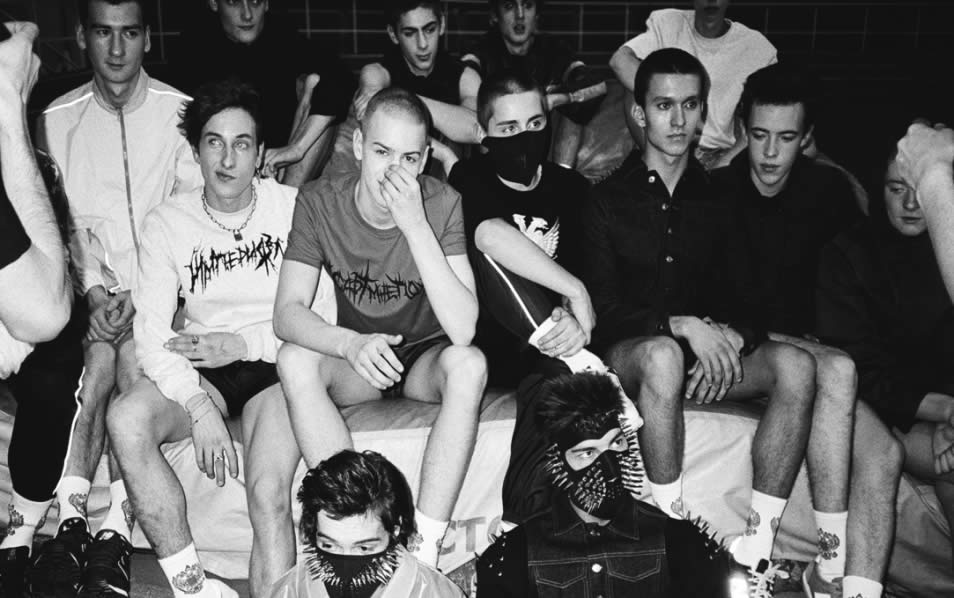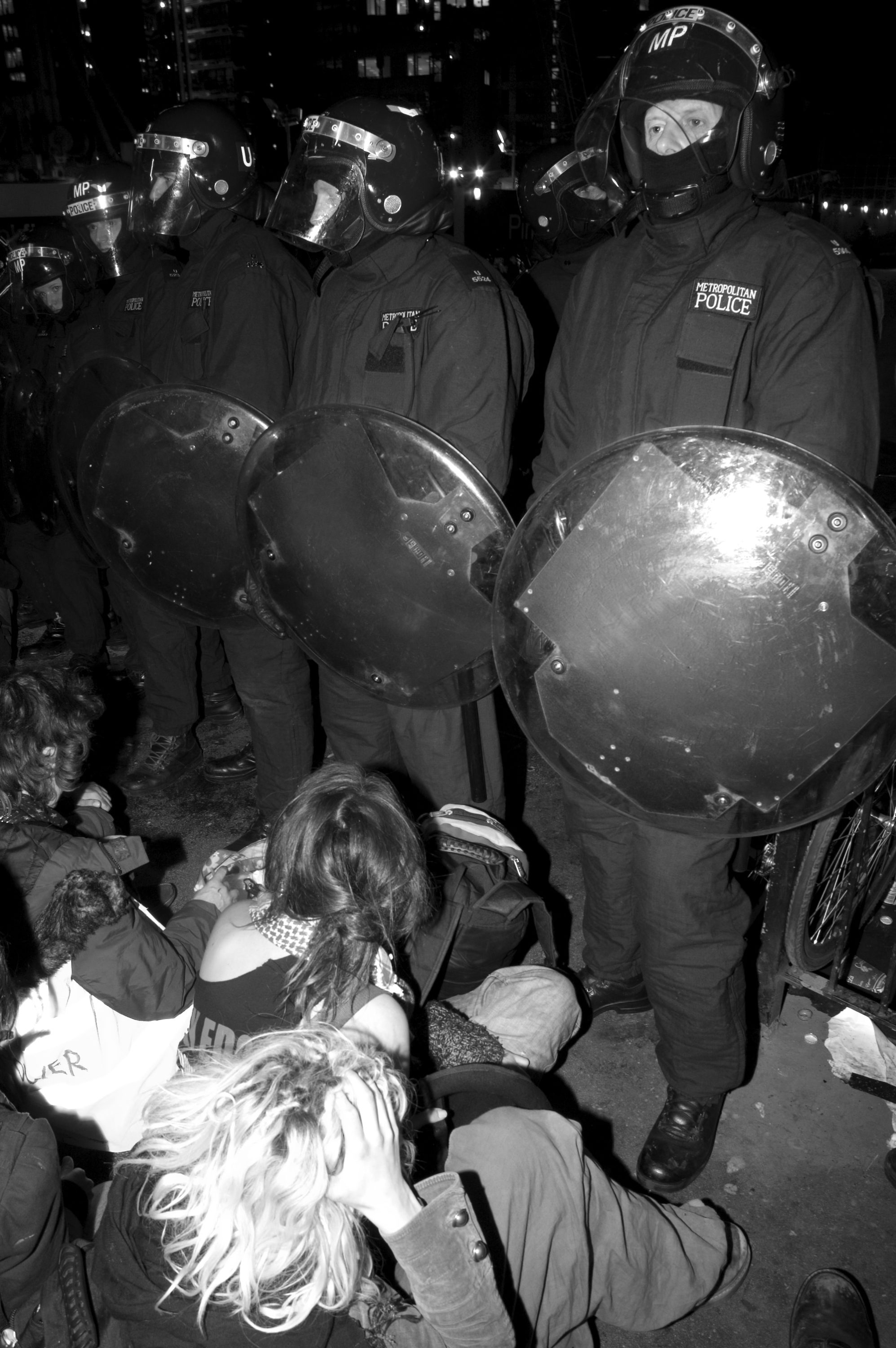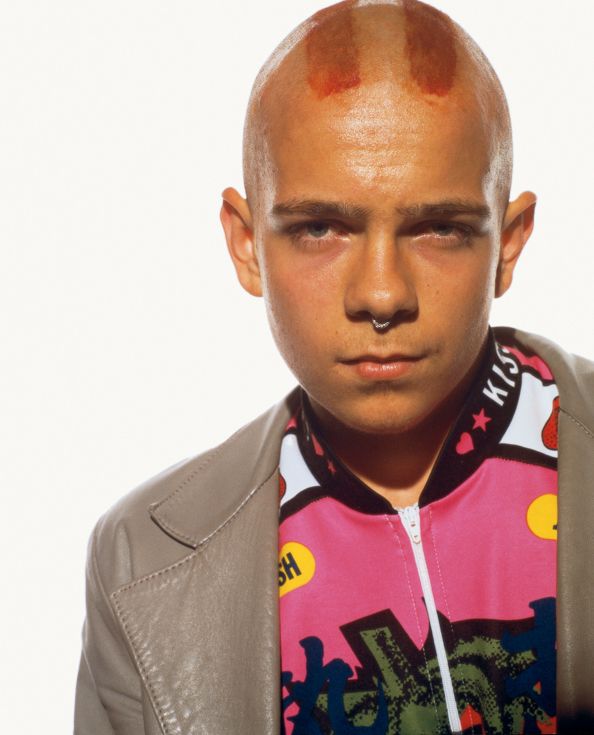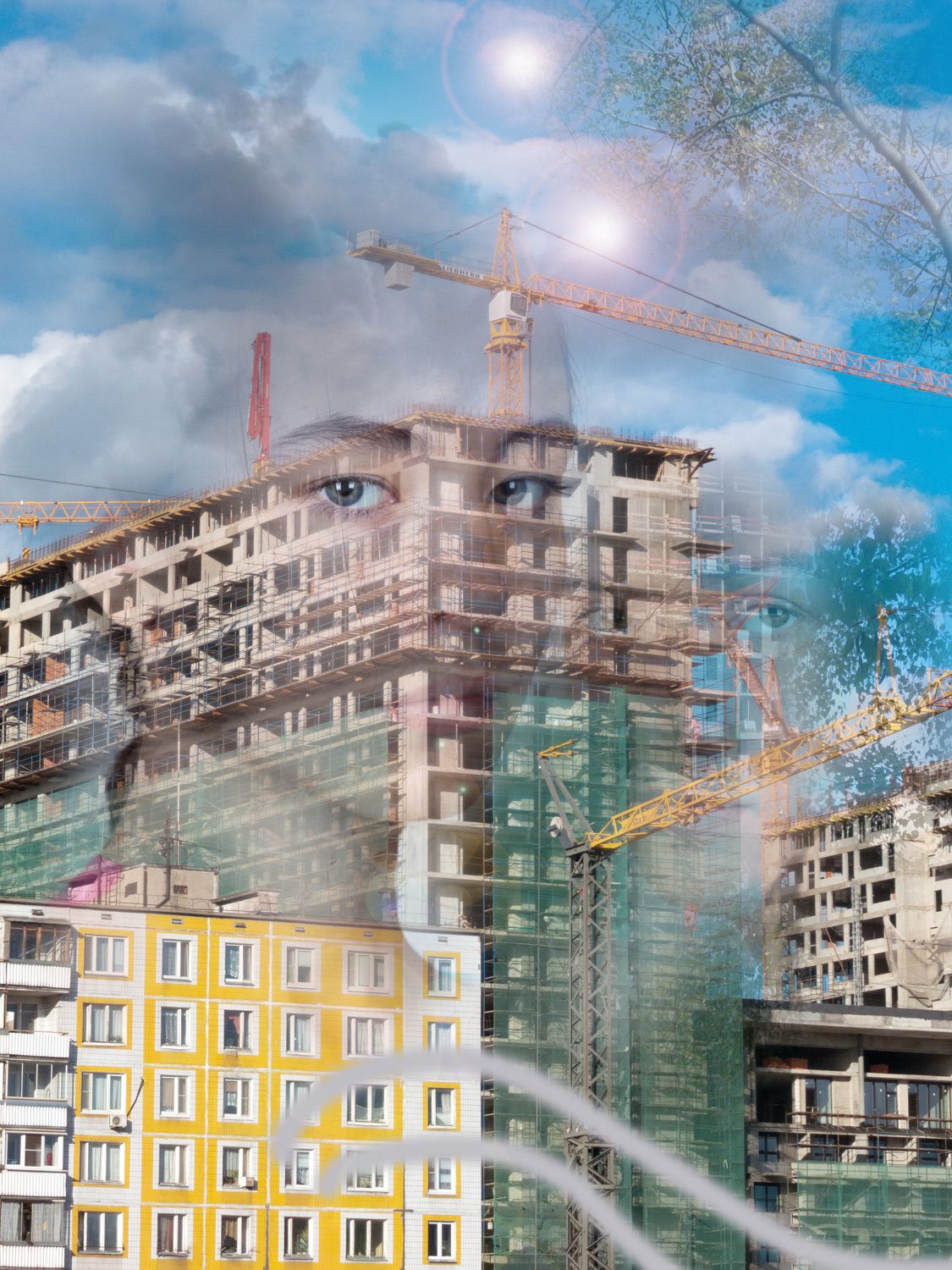GOSHA RUBCHINSKIY: Inside his Vertically Integrated Youth Universe
|ANASTASIIA FEDOROVA
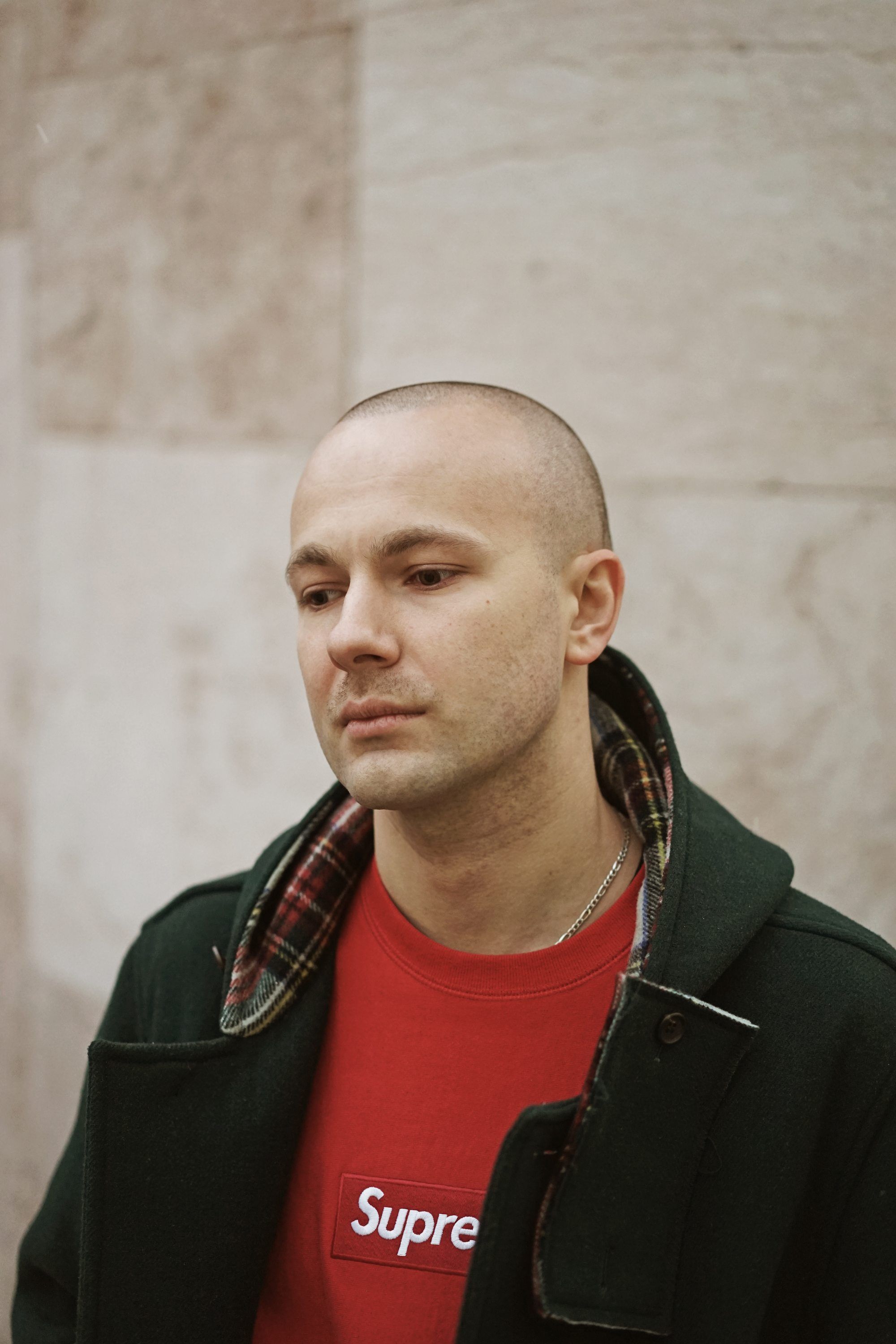
Before 1991, there were no raves in Moscow. Come 9pm, the skyline was pitch black. That changed with the legendary Gagarin raves. Located at the space pavilion of the All-Russia Exhibition Center, the party pirated its name from the Soviet space hero. Three thousand ravers surrounded derelict satellites and rocket engines mounted on plinths, dancing to dark, pulsing acid house. In one night, Soviet heritage was rendered defunct by a wild, undefined energy. “When someone said ‘Gagarin,’” described party organizer Alexei Hass, “a chain of associations suddenly connected. New Composers, Sputnik, Gagarin, the last hero, perestroika, cosmos.”
In 2009, designer Gosha Rubchinskiy took over an Orthodox church turned Soviet gymnasium for one of his first runway shows. He recruited models straight from his own Moscow skate crew, dressing them in biker jackets, dark vests, and baggy green sweatpants. They coolly walked a circular path on bright yellow tarpaulin and then, with a burst of frenzied vigor, scaled an oversized wooden scenography that reached the ceiling above the iconostasis, as if to perform tricks without their boards. As 032c editor-in-chief Joerg Koch recalls: “I was invited over by Moscow’s number one connector, Anna Dyulgerova, and we went with an international group to see Gosha’s first show. Some people wrote it off as an assemblage of sweatshirts and t-shirts, but I was electrified. The attitude of the collection and the scenography was one of undiluted, raw power.”
032c has collaborated with Rubchinskiy on a zine, and two exhibitions since his inaugural collection, which launched during the 2008 Russo-Georgian conflict over South Ossetia. Presenting bold prints emblazoned with bears and assault rifles, he called the collection “Evil Empire,” a nod to Ronald Reagan’s infamous 1983 speech. Seven years after that collection, Russian culture is now simultaneously a subject of fetish and demonization. In the Putin era of hardline anti-gay legislation and anxieties surrounding Syrian intervention, mainstream Western media paints an ever more dystopian image of Russia. At the same time, post-Soviet youth culture has become a style obsession, with images of suburban skinheads, crumbled infrastructure, and Brutalist housing blocks becoming fodder for fashion blogs and mood boards. Under today’s media-schizophrenia, “Evil Empire” resonates more than ever. But Rubchinskiy has already moved on.




Refuting the tag “Post-Soviet Youth” and eschewing easy political statements, he remains enigmatic. “Sport” was the title of his AW-15 collection, yet each piece’s utility as sportswear is more symbolic than functional. Rubchinskiy’s hacked Tommy Hilfiger t-shirt with Russian and Chinese flags encapsulates how a nostalgia for Russian adolescence has been fractured across time and space to address new international concerns – American Prep, Italian Paninaro consumerism, Eurasian geopolitics. Rubchinskiy has taken the iconoclastic spirit of Gagarin and created a new constellation, one that is multilayered, disorienting, and filled with international tensions. Having gained the backing of Comme des Garçons, the designer’s local-driven aesthetic has gained a global reach. In a strange prophetic turn, Rubchinskiy’s own brand may be on the verge of becoming an empire unto itself.
ANASTASIIA FEDOROVA: Where did you grow up, and how did it influence your creative vision?
GOSHA RUBCHINSKIY: I grew up in the north of Moscow. I’ve lived here all my life. I started school in 1991, so the beginning of the 1990s of course influenced me. The school was new and it was surrounded by these freshly built high-rise blocks from the late 80s, early 90s. Such identical courtyards with schools existed all over Moscow, and I’m sure in St. Petersburg as well, everywhere in Russia. I still have these memories – the school, the tower blocks, all very repetitive and strange. It was the same image that you now see in popular Tumblrs about Russia. This is my childhood.
Why do you think so many young artists – and just young people from Russia in general – come back to that imagery now?
I think it has two reasons. The first is that our generation has grown up. Everyone – one way or another – has some sort of nostalgia. Our childhood memories end up being quite romantic, and so these images become incorporated into artistic work. Secondly, it’s a certain cycle of culture. Things that had energy 15 years ago suddenly have it again now. Trends tend to re-emerge every 15 years, because there is just enough time to see it from a distance. Things that once seemed very ordinary now seem very unreal and ephemeral.

Do you think it’s a nostalgia for the 90s?
I think it’s not about a specific time. It’s more about a special state: childhood in that reality. If we talk about Russia and Eastern Europe in late 80s, early 90s, it was a completely different energy. With all the poverty and disorder, there was a feeling of something big and positive coming. Everybody lived with perestroika, and then the atomic explosion of Western culture. I think the nostalgia is for that strong energy, and we can see it looking back – in music, style, magazines, everything.
You mentioned this huge explosion of Western culture. What was your first experience of it?
When you’re a child, you don’t really understand what is Western and what is not. But it was a touch of this unknown world. I remember the clothing markets from the beginning of the 90s. All the traders started bringing these very lush products from abroad, mainly branded goods. You would go to the Stadium Dinamo or CSKA, and they would sell stuff from Milan and Paris: Benetton, Mango, Chanel glasses, Fila sweatshirts, Tommy Hilfiger, giant labels everywhere. I also remember Transformer toys, Ninja Turtles, and VHS cassettes with Hollywood films. The first two years of school we used go watch VHS action films with Stallone and Schwarzenegger.
“The Russians of this generation were true pioneers, and lots of them burned bright. In ten years, they experienced 30 or 40 years of Western culture.”
How do you relive these memories in your own designs? The fact that you mentioned Tommy Hilfiger reminded me immediately of the logo with Chinese and American flags you did in one of your recent collections.
Of course! If the kids who are 15 and 16 now love the 90s, it’s because they know it from photos. But I can say I was there. And I remember these sweatshirts. I try to incorporate these memories, but our aim as a brand is never to copy something that already existed before. It’s not a museum. We want to catch a moment, and with all the 90s hype, this is the moment. The Tommy Hilfiger logo is just a game. You take a reference from the past and fill it with a meaning from today. It’s not about the 90s.
You once mentioned that the Russian magazines Om and Ptyuch inspired you to start thinking about fashion and photography. How so?
I can tell you a story about that. I remember in the winter of 1995, I was going home after school and I had to go one stop on the metro. It was a frosty day, and I walked past a kiosk that sold newspapers and magazines. And I remember this glossy cover that said “OM.” I spent all my pocket money on this magazine, took it home, and it was an aesthetic shock. I was 11 or 12, and I saw this magazine full of awesome shoots, stories, articles on drugs, sex, whatever. It was a door to a new world that I never even knew existed. Om became like a bible. I couldn’t buy every issue, because it was very expensive for me as a kid. But I had a friend, and we had a deal. I bought Om, he bought Ptyuch, and we would trade. We both still have the complete sets of these magazines.
Do you ever revisit these magazines to get inspiration today?
Yes, of course! Even now, it remains a real fashion manual. The Russians of this generation were true pioneers, and lots of them burned bright. In ten years, they experienced 30 or 40 years of Western culture – Studio 54, Detroit techno, everything. Lots of them didn’t live past the 90s, but that’s what our generation grew up on, and we owe them a lot.
Fashion and photography really go hand-in-hand in your creative process. What came first when you were starting out?
Everything started from the magazines. I realized at that age that I wanted to be on those pages. After school, all my classmates went to Stroganov College to study classical art or graphic design, but I wasn’t interested in it. I was into this world of fashion and clubs, but there was no university for that! It took ages to decide what to do, and finally I enrolled in college to become a hairdresser and a makeup artist, because I thought it was at least somehow connected with fashion. Eventually, I started photographing my college projects and also carrying a camera around to take pictures of my friends. I had an old SLR Zenit camera. But I remember when I met Slava Mogutin in like 2002, he had come to Moscow from New York and brought an Olympus point-and-shoot. And he was like: “Gosha, why are you dragging around that SLR? Olympus is much cooler.” I think Terry Richardson showed him that camera, and he showed it to me. You could always take a quick snapshot with that camera, the way Wolfgang Tillmans does. Slava was really inspired by Richardson and Tillmans.
One of the defining points of your aesthetic is skateboarding. How did you get into it?
In about 2003, I started noticing skaters around town – at Novyi Arbat and other spots. Every time I saw someone with a skateboard, I was really attracted to this energy. I was very into how they look and I loved the combination of sport and style. For me, skateboarding is always connected to art and fashion. Some skaters dress like classic skinheads, some have long hair, and I was very attracted by it.

Was there a scene around skateboarding in Moscow at the time?
Later, in around 2006, new parties started happening in Moscow. In the 90s, there were underground clubs and raves, but in the beginning of the 2000s, it was more posh clubs, luxury places where youth was not welcome. At the time, I was hanging out with the fashion crowd and I could get into these parties, but I was so bored. I was working at magazines and fashion shows as a stylist but I wanted nothing to do with fashion weeks, clubs, and all these people. When the young kids started doing their own parties, a new energy started coming to the surface. The crowd was more mixed – fashion people, random teenagers, skaters. I went to one of these parties on a rooftop by the Lenin Library, and there was a skate ramp with kids from Noviy Arbat. I spent the whole party by this ramp watching how the guys were skating and making friends with them. I’ve been hanging out with those guys ever since. I dumped all my friends from the fashion world and started hanging around skate spots taking photographs. There were house parties, trips to St. Petersburg, barbeques on abandoned piers with gabber blasting from the speakers. It was all unreal.
“Reality is reality, and a fashion show is a fashion show.”
How did it all transform into part of your aesthetic?
There was a point where I realized, “This is it.” This is something I’ve been moving towards all my life – this is the image, this is the hero, this is the fashion I want to do. I had the knowledge by then of how fashion works and decided to make my first collection. We didn’t think about the future. I wanted to show others what I saw myself – the guys, the style, us. This is still the key to the brand. It was all a game at the start. We never thought it would become a serious fashion brand. Your first show was at a stadium, and your second was at a sports hall converted from a church. They both had this really powerful, youthful energy.
You took the street and put it on the catwalk. But do you think something gets lost in this transition?
Of course. Reality is reality, and a fashion show is a fashion show. The show is an illusion – a performance, a creative act. The clothes are also a business. You can still use references from the street, but in any case, when you’re at the fashion show, you’re entering the world of Gosha Rubchinskiy, not the Moscow streets.
What memories do you have from producing these first collections? How does it look to you now?
It was completely DIY, improvised, and quite unprofessional. During production, we were running around all of Moscow during a very hot summer – all sweaty, with fabrics and bags. It was a nightmare.
I’m amazed that you managed to do it without any fashion infrastructure behind you.
Our enthusiasm and our energy was crazy! Then, when Dover Street Market came and asked to have our collection in their store, we realized that we didn’t even know how to produce it. It was complete hell. It all sold, but it didn’t make any sense, because all the effort and resources were not justified. We didn’t really make any money. This is how my story with Comme des Garçons started. I said that if they were interested in selling the collections, they should help with the production, because we would spend all the money they paid us on shipping. It took us six months to decide, and then we produced the first collection together. That was how the new history of the brand started. The first show was titled “Empire of Evil.”

Remembering your first collections, I’ve always been enchanted by the collection title you came up with, “The Dawn is Breaking over the Mountains”. It reflected what was in the air at the time so well.
It was one of those magical things that just appeared on its own. “The Dawn is Breaking Over the Mountains” was the name of the third collection. All of the titles were not simple. They had to carry their own energy. The first show was titled “Empire of Evil.” It was my reaction to the conflict between Russia and Georgia, and the whole information war that was taking place in the Western media. I thought, “Let’s show the bear’s teeth!” Bears with Kalashnikovs were all over the sweatshirts. The second collection was called “Growing and Developing,” it was a transition from black to white. Now, our main concept is rassvet, “the dawn.” We have crossed the mountains.
One of your long-term collaborators is Pasha Milyakov from John’s Kingdom. He makes music for almost every show. How long have you been working together?
Pasha also came from skateboarding and then he started doing graphic design. We worked together on the first collections. He was doing prints, graphics, and graphic design for our zines. We actually started the first zines and photobooks because Pasha wanted to make print material. Then we had a break. I was busy with fashion and Comme des Garçons, and he lost interest in graphic design and got into music. But now we’re working together again, because his music fits perfectly with what I do now. The label John’s Kingdom is the most interesting thing in the underground electronic music of Moscow at the moment, and I felt I like I had a mission to show it, because it’s an insight into what happens in Russia. They do parties and bring artists from all over the world – similar to what was happening in the 90s with underground music. We’re going to release a vinyl with Pasha, which is also going to be a supplement to the new photo book with Idea Books.
Amazing. What’s the book about?
The book is called Youth Hotel. We’ve done a few shoots with my friend Lotta Volkova in Moscow, and she always stayed in Hotel Molodezhniy. It was built for the 1980 Olympics for the youth teams. The building is really cool. We used to have photo shoots and parties there. You can get a very big room for quite cheap and hang out, like 20 people in the room. So I had archived my photographs from there. I think it’s a great name, “Youth Hotel.” It’s a very romantic name, because a hotel is a place where you can stay for a bit and leave, and youth is a transient stage. So with this book I wanted to invite everyone to stay in this world of youth.



















The Californian artist Julian Klincewicz recently made a couple videos for you. How did this come about?
At the end of last year, we found each other through Instagram. He’s a photographer, video artist, musician, a model – an interesting dude. For the new collaboration with Vans, we needed to create a separate project, and Julian has always wanted to visit Russia, so we invited him there. I usually do everything myself and I think Julian was the first person who I allowed into my world. I thought it was also interesting to see an American perspective, a combination of cultures. In a moment when there is all this tension between countries that is artificially created by the politicians, it’s important to show the things that unite us. Skateboarding and fashion and art are these things that bring people together. Every day I get teenagers from the UK and the US who wear t-shirts with Russian and Chinese flag logos. It makes me feel like an undercover KGB who is trying to seduce foreign youth.
There’s a certain discourse centered around the tagline “Post-Soviet Youth,” and it always makes an appearance when your work is discussed. Do you think our generation could really be described like this, or is it a media construct?
I think it’s a cliché invented by the media. They can’t come up with a name for the energy that comes from this part of the world. This new generation does the same things as youth from around the world. They are the same guys who Hedi Slimane photographs in California. But with us, they just call it “Post-Soviet Youth.” I hate tags and I hate borders. That’s exactly why we used the hammer-and-sickle in the latest collection. It was pure irony.
“Long live communism! Put on your hammer-and-sickle t-shirt and go out skateboarding!”
So you think this post-Soviet idea is imposed from the outside?
Yes, completely. Long live communism! Put on your hammer-and-sickle t-shirt and go out skateboarding!
But surely a lot of people don’t get the irony.
It doesn’t matter. I think with any artistic act, you put one meaning into it, and people see something different. I have my own meaning, and it would be silly to try and explain.
It seems as though your work is focused on an emerging generation, very young kids. Are they your new heroes?
Everything I do is about today. I am more interested in the energy of the moment. Youth has the energy and an interesting vision of the past. They can process the past into something current in a very fluid way. I always look towards youth, because it nourishes me creatively.

Have these kids formed an underground?
For me, something real is always intimate. It’s something that happens between friends in a special community. When things stop being intimate, what you call an underground begins to lose its energy. I don’t like the word “underground.” I’d rather think of things in terms of their energy and power. Of course, sooner or later, it loses that energy and becomes popular. That’s why I’m always in search of this energy – fresh blood, youth, subcultures, DIY parties.
A lot of people reference Larry Clark when talking about your work, although he speaks about a different country and a different generation. How to do you position yourself next to him?
Well, in order to say words, you need to know letters. For me, artists like Clark, [Gus] Van Sant, and Wolfgang Tillmans are teachers. I learned visual tricks from them. I learned letters. But you don’t have to repeat their words, you can tell your own story. I think this is the reason why what I do is so popular and understood all over the world. I speak the universal language, but I bring the messages from Russia that people were not aware of.
When you begin working on a collection, how do you compile references and inspirations?
I keep a folder with all of the things that interest me over the course of a year, and when the time comes to start working on a collection, I just open the folder. The collection is often done in a rush. Usually, it’s people, travel, maybe even a certain person I’ve met – how he was dressed, a photograph. I am interested in people and their energy. This happened with the last collection. I was going out to parties in Moscow, saw a couple of guys, created a collection about their style, and then took them to Paris to walk in the show.

How was it for the guys to be in Paris?
It was crazy! We had a big crew, about ten of us. We rented a huge flat and all lived there. We took skateboards, friends, a huge crowd. For me, this is something real, not just a commercial show. It’s more like a performance, with these people who are part of your idea. You find guys in a Moscow bar, take them to Paris, and show them to the whole world.
Considering your interest in the energy of today, it’s quite hard not to mention the political – the rise of Russian nationalism, for instance. How do you feel about it? Are you trying to distance yourself from it?
Being in Russia at the moment, I wouldn’t call it nationalism. I’d call it the rise of patriotism and community. It feels positive. The pressure from the outside only benefits the young people, because they feel better about their country. Of course, all the fights in the press where people are divided into “us” and “them” are just bullshit. But on the other hand, there is a great international unity of young people. I think young people don’t give a shit about politics. They don’t listen. They don’t believe in it. When we were in Paris this summer, we met local skaters. We were hanging out, drinking beer, and they were very excited to hear that we were Russian. They were like: “Oh wow, that’s awesome! Tell us how it is, because we watch the news and we don’t believe any of it. Tell us it’s all wrong.” I get a massive amount of messages from teenagers all over the world – from Korea, China, US, UK. Everyone’s crazy about the Russian typography on t-shirts, sweatshirts with Russian and Chinese flags. This whole information war only enhances the interest in Russia. Of course, it’s hard. Propaganda literally comes from everywhere – from both sides, in Europe and in Moscow. It’s just a fight for money and resources and business. I’m sick of politicians’ faces. Nobody knows what they fight about. But I feel a great energy that comes from youth all over the world. Old people can keep making wars for money, but we’ll grow up and change the world. I hope.
Credits
- Interview: ANASTASIIA FEDOROVA
